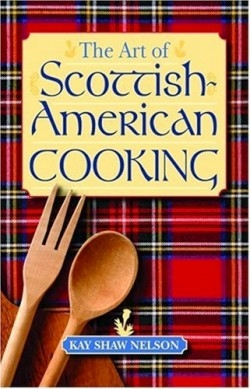The Art of Scottish-American Cooking
The most surprising aspect of Scottish-American cuisine is not the amusing names of dishes such as Inky Pinky, a hash, or Rumbledethumps, a potato-cabbage dish. Nor is it the sometimes exotic ingredients, like the sheep’s lungs which make authentic haggis impossible in the United States. Rather it is how quintessentially American a number of the recipes are, as Shaw Nelson traces such down-home favorites as fried chicken and apple pie to their Scottish forebears, while gathering the culinary customs of Scottish-Americans in the United States and Canada.
Having played such an important and lasting role in the United States, Scottish-American food informs everyday American fare at its heart, yet remains proudly distinct. “Although Scottish cooking is rarely acknowledged as noteworthy, the descendants of the Scots are instinctive, genuine cooks who take great pride in the preparation of food and who added their traditional recipes to the American cuisine, often with remarkable adaptations,” she writes.
Shaw Nelson, once a CIA intelligence officer, has written twenty cookbooks, including A Bonnie Scottish Cookbook and The Scottish-Irish Pub and Hearth Cookbook. She employs her extensive experience abroad as well as her Scottish-American heritage to craft this thoroughly informative yet eminently approachable collection of recipes. A hearty and direct cuisine, the offerings include “Helen Lille’s Scotch Rarebit,” “Carolina Shrimp Boil,” “Giant MacAskill’s Porridge,” and recipes for everything possible with oats. A key Scottish ingredient, oats are employed in nutritious porridges, puddings, unleavened griddle-cooked bread called bannock, ubiquitous biscuit-like oatcakes, and even beverages, such as “Atholl Brose,” which uses oat water. Shaw Nelson also pays particular care to educate her reader on other Scottish staples such as crowdie, a type of cottage cheese; kippers, a salted and smoked fish; and whisky, which came to prominence in America by the 1700s.
The most tempting section of the book covers baked goods and desserts. “The art of baking has long been the glory of the Scottish kitchen,” she writes, and quotes an early food writer as saying, “Every Scotswoman is born with a rolling pin under her arm.” Special attention is given to the shortbread, with a recipe for “Petticoat Tails,” whose shape is intended to mirror nineteenth century women’s fashion.
Given this book’s clear and friendly style, and the ready availability of the majority of the ingredients, even novice cooks will be able to easily dabble in the art of Scottish-American home cooking and better appreciate its innumerable contributions to American culture.
Reviewed by
Naomi Millán
Disclosure: This article is not an endorsement, but a review. The publisher of this book provided free copies of the book to have their book reviewed by a professional reviewer. No fee was paid by the publisher for this review. Foreword Reviews only recommends books that we love. Foreword Magazine, Inc. is disclosing this in accordance with the Federal Trade Commission’s 16 CFR, Part 255.

